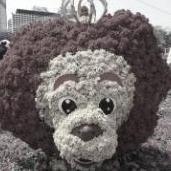
pateceramics
Members-
Posts
801 -
Joined
-
Last visited
-
Days Won
98
pateceramics last won the day on July 27
pateceramics had the most liked content!
About pateceramics

Profile Information
-
Biography
I'm 33, and just got into composing over the last year or so, although, I was always the kid who made up an extra harmony part when singing along to the radio. When I was a very shy teenager, I'd sing a little harmony part when we sang at summer camp, and other people picked the part up until, suddenly we had two parts. And then I'd make up another part, and other people would pick it up too, and then there were three parts. It made me unbelievably happy.
Since I'm mainly a singer, I've been writing for a cappella choir, but when I feel a little more sure of myself I'd like to learn to write a decent piano part if nothing else.
Over the years I've had 5 violin teachers, 2 banjo teachers, a brief fling with penny whistle lessons, 3 voice teachers, and sung with 2 a cappella groups, 7 choirs, and a wee bit of musical theater which got me out of taking gym in high school. Thanks for the warm welcome to this community and your continued feedback. Can't get better without feedback! -
Gender
Female
-
Location
Malden, MA, USA
-
Occupation
contralto, potter
-
Favorite Composers
Vivaldi, Brahms, Lauridsen, Thompson, Gillian Welch
-
My Compositional Styles
Eh, you tell me.
-
Notation Software/Sequencers
MuseScore
-
Instruments Played
alto, clawhammer banjo
Recent Profile Visitors
22,911 profile views
pateceramics's Achievements
-
Harvard's Ferris Choral Fellows, directed by Carson Cooman, Harvard's Composer in Residence, were kind enough to use this piece in a Morning Prayer service at Memorial Church. They sang the a cappella SATB version of this piece, so I thought I would share the recording here. Enjoy!
- 4 replies
-
- maundy thursday
- good friday
-
(and 7 more)
Tagged with:
-
Sometimes I put things away for a while. Sometimes I don't come back to them because they really weren't working, but something else will. Oh, well. There's always the next one... 🙂
-
Do you have music in the works for this one, Brianna? It looks like a good start!
-
My piece is more serious in tone, but I do like PDQ Bach. "Found a peanut!" Least expected opening line of an opera ever. 🙂
- 6 replies
-
- wildlife rescue
- satb
-
(and 2 more)
Tagged with:
-
I've been going through older pieces and making multitrack recordings of them with myself singing all the parts. Hopefully this provides a better sense of the piece, even with an alto singing the bass line, and some resulting sound distortion from Garageband's transpose feature...
-
Gotcha... You could just add some accents to indicate where the strong beats are when they contradict the meter, since your music isn't following the meter in the way people assume. You can also group notes together with brackets over the top of the bars. Some editors/composers do that to show a hemiola, so people would understand what you meant. And don't worry, I believe you that you can see the video just fine. I've got particularly terrible eyesight. But I'm not the only person who does, so if you can figure out a way to get fewer bars on the screen at once, so everything is bigger, that would probably be helpful. 🙂
-
I like your "Holy Spirit" but I think the explanatory note at the beginning is a bit too much. You ask about professional looking scores? To look professional, assume professionalism on the part of your musicians. You might write easy parts that can be put together without a lot of rehearsal time, but any choir should understand a simple "stagger breaths throughout" without further explanation on your part. The conductor/director can explain what that means if any choir members are very new to singing. I'm not sure about the direction to take this piece out of time like Gregorian chant. The accompaniment is very metrical, except for the first few bars, and as such will impose a strict rhythm on the singers. Did you just mean for that instruction to apply to the first few bars? If so, then indicate where strict tempo resumes. If you meant for the whole piece to be a bit loose-y goose-y then a direction for "rubato" here and there may better achieve what you are looking for while keeping accompanist, conductor, and choir together. Cheers! Sounds nice!
-
The 1080 resolution is still not enough for me to be able to see your score clearly with my middle aged eyeballs. I'd recommend making your videos with fewer bars visible at once so the notes and text are bigger for people viewing on a laptop screen instead of a large desktop monitor if you want them to use the videos as a promotional tool to encourage purchase of your sheet music. Certainly sounds nice, but I'm too blind to see it to give more detailed feedback! You can also post a pdf of the score and a sound file for people to use here to review your work. 🙂
-
Aurora (Ancient Greece inspiration)
pateceramics replied to Luis Hernández's topic in Piano Music, Solo Keyboard
Very interesting stuff, Luis, I'm sorry I'm late to the party to comment! This sort of exploration is exactly the sort of thing that composition software is good for. Means you don't have to retune a whole piano to find out what it would sound like. An excellent use of modern resources to imagine ancient sounds! The introduction is beautiful and a little unnerving, and the section that begins around measure 25 is just a strange but confident loveliness. What an interesting sound world you have brought us to! -
I guess the point is not that there shouldn't be repeats, but that they should still serve to move the narrative forward. Da capo aria? The first time the performer introduces the material, the second time they are encouraged to make it their own with ornaments or other small changes. But for this exercise, the structure of what you were doing with tritones and scales is firm enough that there isn't much room for experimentation or nuance when it's played through again. Welcome to the forums! And I disagree! If you're alive, you are getting exposed to new musical ideas and influences which are sure to keep you growing. Cheers.
-
Thanks, Henry! Yes, the beginning is a jazz minor scale (melodic minor ascending used for both the scale up and the scale down) with fourths raised for a bit of extra leading tone (leading tone to the fifth). And then we flip around a bit between Mixolydian and eventually a nice bright C Major. One of my bigger challenges with this piece was being sure that Whitman's lovely text would be heard through everything that is going on. It's a long and wordy text and I knew I wanted to work the "all flesh is as grass" in as well as a second idea. The text ends up similar in length to the "credo" section of the big masses, so it presents the same problem of how to fit it all in. I ended up doing a fair amount of homophonic writing in the early parts of the piece to keep the text clear and understandable and using the piano part to keep things lively, as well as having different voices come in and out to add emphasis to certain lines and keep things interesting. But by the second half, the singer may have a disorientingly fragmented experience, since I was often needing a voice part to switch back and forth from the poem to the biblical text in mid-thought to try and keep the lines from becoming too tangled with each other. To avoid some overlapping of people singing different texts simultaneously, I chopped the lines into little pieces and stitched them back together as a quilt to get the important words to punch through. Hopefully it's not too jarring an experience. The Catholic Church's Council on Trent (1545-1563) apparently specifically condemned this kind of polyphonic tomfoolery, feeling that interfering with the understandability of a text was missing the point of singing as a mode of communication. But of course, then what the heck do you do about the credo section of your choral mass to keep it from being boring and ten minutes long if you are composing for the church?
-
Excellent! I love the way your ARJUNA theme skips along rhythmically in the violin part; the whole piece has such a lighthearted feel to it. I would have liked a little more bold variety to the repeated wind blows fair, wind blows cold theme that we see in the violin at measure 62, since it comes up several times. It feels like you could have pushed the harmonic surprise there a little more in those places, but I know you said you were also trying to simplify your ideas in this piece. Excellent job keeping both parts varied for interest and letting them interact with each other in diverse ways that will let the musicians enjoy bouncing off each other's musical ideas. This seems very fun to play! I hope you'll enjoy it!
-
This piece contrasts an excerpt from Walt Whitman's preface to Leaves of Grass with 1 Peter 1:24 "All flesh is as grass...", otherwise known as the best part of the the thoroughly excellent Brahms Requiem. Whitman's text urges us to think for ourselves and do the right thing, letting our lives speak for our morals. The biblical passage reminds us that our lives are beautiful, but short, lending urgency to Whitman's words. There is only so much time. “…read these leaves in the open air every season of every year of your life, re-examine all you have been told at school or church or in any book, dismiss whatever insults your own soul, and your very flesh shall be a great poem and have the richest fluency not only in its words but in the silent lines of its lips and face and between the lashes of your eyes and in every motion and joint of your body...” -Walt Whitman For all flesh is as grass, and all the glory of man as the flower of grass. The grass withereth, and the flower thereof falleth away: 1 Peter 1:24
-
I like this so much! His poetry is so evocative of a time and place, while simultaneously the speaker could be someone you pass on the street today. The rocking rhythm of your piano accompaniment feels appropriate to an evening spent lying on the carriage roof, soul twirling along with the smoke. Your harmonies around 1:10 work very well to inject a little melancholy and mystery to "pourquoir me comprenez-vous pas?" You do an excellent job of turning your musical language to follow the narrator's emotional journey, while still producing a cohesive piece. Bravo!




.thumb.png.8b5b433a341551e913a34392660bc95b.png)





